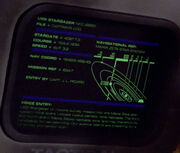mNo edit summary |
m (Robot: Automated text replacement (-{{[Nn]Cwiki +{{mbeta)) Tag: apiedit |
||
| (11 intermediate revisions by 8 users not shown) | |||
| Line 1: | Line 1: | ||
| − | [[File:Veridian system.jpg|thumb|The [[Veridian |
+ | [[File:Veridian system.jpg|thumb|The [[Veridian system]]]] |
| + | [[File:USS Stargazer log 1.jpg|thumb|The [[Maxia Zeta system]]]] |
||
| − | {{bginfo|"Solar System" redirects here. For the star system in which the planet [[Earth]] is located, see [[Sol system]].}} |
||
| + | {{disambiguation|[[Earth]]'s solar system|Sol system}} |
||
| − | A '''star system''' |
+ | A '''star system''', also known as a '''solar system''', a '''planetary system''' or simply as a '''system''', is the area around a [[star]], or a [[multiple star system|group of stars]], that contains all of the [[planet]]s, [[moon]]s, [[asteroid]]s, [[nebula]]e and other landmarks which are held in place by the star's [[gravity well]]. ({{TOS|The Cage|Elaan of Troyius|The Doomsday Machine|Patterns of Force}}; {{ENT|Broken Bow}}; {{DS9|Starship Down}}) |
| + | {{bginfo|In the real-world, the term {{w|star system}} is used exclusively of a group of at least two stars that orbit each other or a common center of gravity, not necessarily containing any planets.}} |
||
| ⚫ | |||
| ⚫ | Star systems have a habitable zone where the [[inhabited planets]] and planets that can be [[Terraforming|terraformed]] are located. ({{TNG|The Battle}} ''display graphic'') A star system's boundaries are marked by the area in which a star or celestial body's [[gravity|gravitational force]] affects its surrounding environment. Often the edge of these boundaries is a large, thin layer of [[ice]], dust and debris called an [[Oort cloud]]. ({{DS9|The Maquis, Part II}}) |
||
| − | The planets and other bodies in a solar system [[orbit]] the star (or stars) at different distances; these distances can be classified into three distinct ''zones'': (1) the '''hot''' zone, which is closest to the star, produces temperatures prohibitive of [[lifeform|life]], such as on [[Mercury (planet)|Mercury]]; (2) the '''ecosphere''' zone, where life can find a foothold and flourish, given the balance between solar [[energy]] received and [[radiation|radiated]], such as [[Earth]], [[Vulcan]], and [[Bajor]]; and (3) the '''cold zone''', which lies farthest from the star and receives the least energy; [[Pluto]] orbits in the cold zone, where Sol appears merely as another bright star. |
||
Using [[warp drive]] to travel from within a solar system to another point in the system is not recommended. The {{USS|Defiant|2370}} performed such a [[Maneuvers and tactics|maneuver]] in [[2373]] in the [[Bajoran system]]. ({{film|1}}; {{DS9|By Inferno's Light}}) |
Using [[warp drive]] to travel from within a solar system to another point in the system is not recommended. The {{USS|Defiant|2370}} performed such a [[Maneuvers and tactics|maneuver]] in [[2373]] in the [[Bajoran system]]. ({{film|1}}; {{DS9|By Inferno's Light}}) |
||
| + | In [[2254]], [[Spock]] compared the [[Talos star group]] to the [[Earth]] solar system. ({{TOS|The Cage}}) |
||
| − | {{bginfo|Although many star systems have been described in detail in ''[[Star Trek]]'', additional information for this article has been derived from real-life [[science|scientific knowledge]].}} |
||
| − | == |
+ | ==Appendices== |
| + | === Related topics === |
||
| − | *[[Stars and stellar bodies|List of stars and stellar bodies]] |
+ | * [[Stars and stellar bodies|List of stars and stellar bodies]] |
| + | |||
| + | === Background information === |
||
| + | In the {{st-minutiae|academy/literature329/tmp.txt|shooting script}} of ''[[Star Trek: The Motion Picture]]'', the film would have begun in deep [[space]]. After witnessing a [[supernova]], the camera would move on searching for ''[[V'ger]]''. In its search, the camera would have seen the "''jeweled beauty''" of star systems. |
||
| + | |||
| ⚫ | |||
| ⚫ | |||
| ⚫ | |||
| + | * {{Wikipedia|Planetary system}} |
||
| ⚫ | |||
| ⚫ | |||
| ⚫ | |||
[[de:Planetensystem]] |
[[de:Planetensystem]] |
||
| Line 23: | Line 30: | ||
[[ja:恒星系]] |
[[ja:恒星系]] |
||
[[nl:Zonnestelsel]] |
[[nl:Zonnestelsel]] |
||
| + | [[pl:System gwiezdny]] |
||
[[Category:Astronomical objects]] |
[[Category:Astronomical objects]] |
||
Revision as of 20:40, 4 July 2015

The Veridian system

A star system, also known as a solar system, a planetary system or simply as a system, is the area around a star, or a group of stars, that contains all of the planets, moons, asteroids, nebulae and other landmarks which are held in place by the star's gravity well. (TOS: "The Cage", "Elaan of Troyius", "The Doomsday Machine", "Patterns of Force"; ENT: "Broken Bow"; DS9: "Starship Down")
Star systems have a habitable zone where the inhabited planets and planets that can be terraformed are located. (TNG: "The Battle" display graphic) A star system's boundaries are marked by the area in which a star or celestial body's gravitational force affects its surrounding environment. Often the edge of these boundaries is a large, thin layer of ice, dust and debris called an Oort cloud. (DS9: "The Maquis, Part II")
Using warp drive to travel from within a solar system to another point in the system is not recommended. The USS Defiant performed such a maneuver in 2373 in the Bajoran system. (Star Trek: The Motion Picture; DS9: "By Inferno's Light")
In 2254, Spock compared the Talos star group to the Earth solar system. (TOS: "The Cage")
Appendices
Related topics
- List of stars and stellar bodies
Background information
In the shooting script of Star Trek: The Motion Picture, the film would have begun in deep space. After witnessing a supernova, the camera would move on searching for V'ger. In its search, the camera would have seen the "jeweled beauty" of star systems.
External links
- Star system at Memory Beta, the wiki for licensed Star Trek works
- Star system at Wikipedia
- Planetary system at Wikipedia
